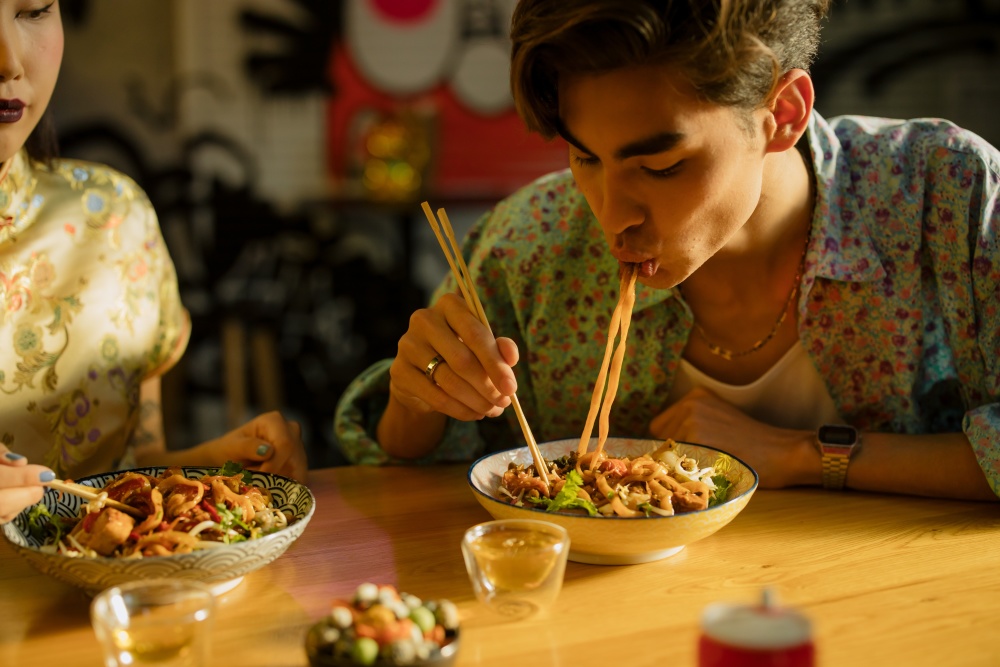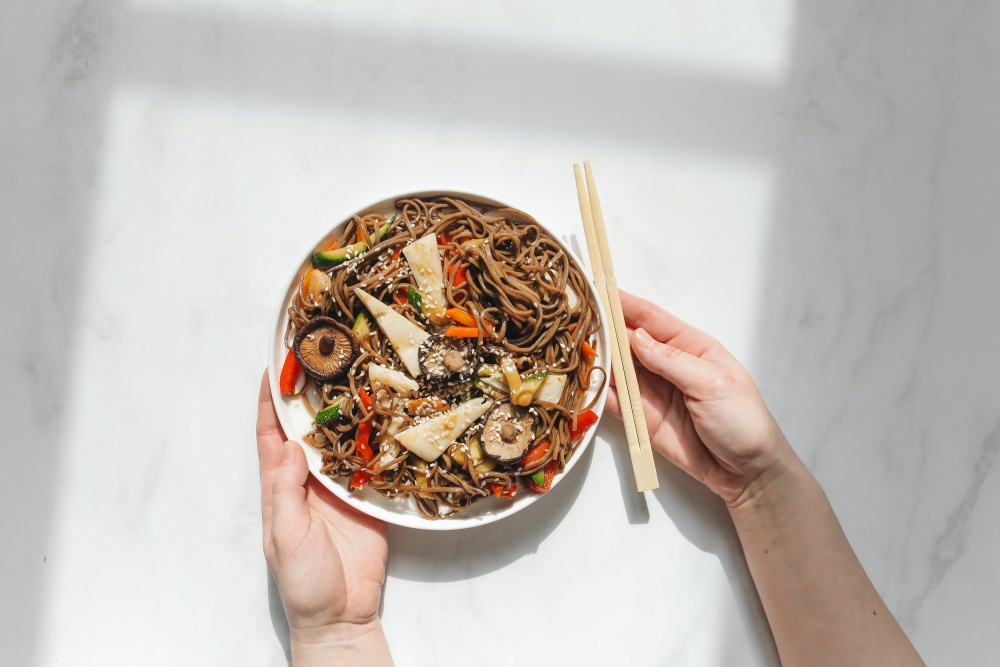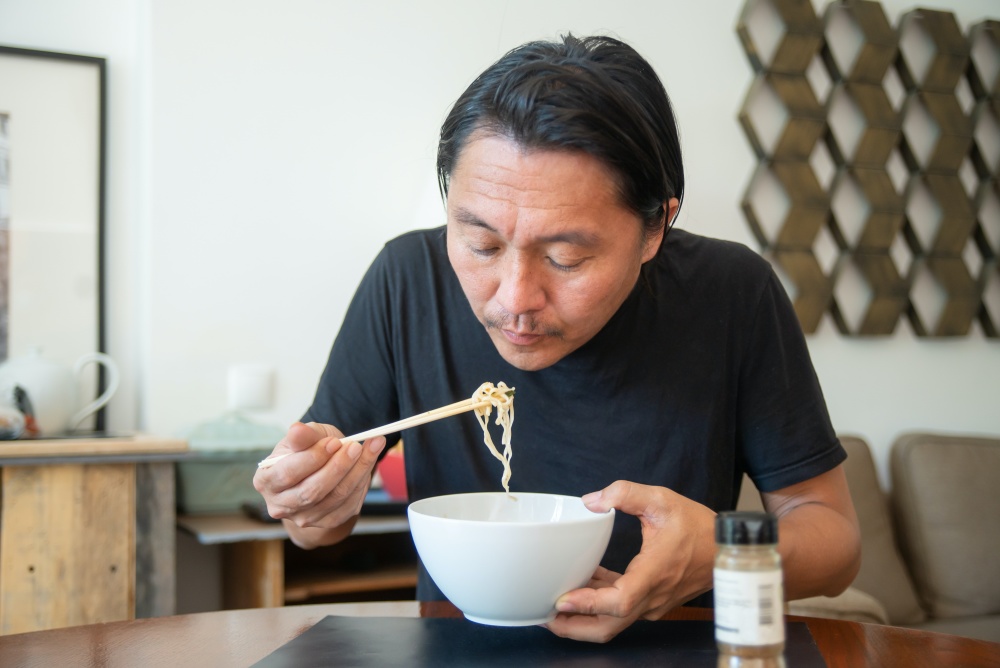Updated August 11, 2023
Types of Japanese Noodles: The Essential Guide
Noodles are the main ingredient of many popular dishes around the world, and they’re also one of the most prominent essentials of Japanese cuisine.
Be it a warm bowl of soup or a hearty stir-fried dish, noodles can be paired with any food you like and can be prepared in many different ways. It’s just an exceptionally versatile ingredient.
However, while most people around the world are familiar with noodles, most only know a few basic varieties. In reality, Japan has many more types of noodles to offer, all served in specific ways boasting textures and flavors.
Today, I’m here to explore the most prominent ones and see what they’re all about. First, let’s briefly talk about the significance of noodles in Japanese culture.
The Prominence of Noodles in Japanese Cuisine
Even though noodles are a significant part of Japanese cuisine today, and most people associate them directly with Japan, they didn’t originate in Japan. They were brought from China and were introduced to the country during the Heian period, which was around 800 A.D.
Due to the fact that you could practically cook different meals every day using different accompanying ingredients, noodles became instantly popular and were even titled as common samurai food later, around 1100.
However, it wasn’t until the Edo period, which was around 1600, that noodles started to gain popularity and become widespread around the world.
With Kendon Soba — a restaurant specializing in soba noodle-based dishes — becoming significantly popular around this time, soba noodles quickly became the most popular dish in eastern Japan. In a similar fashion, udon noodles gained popularity in Western Japan and came to symbolize the western region of the country since then.
Today, almost every region of Japan has its own special type of noodles, ramen, and noodle-based dishes. With all the different serving styles and the fact that they can be enjoyed both cold and hot, Japanese noodles are a true staple of Japanese cuisine today.
An Overview of the Types of Japanese Noodles
As you may know by now, noodles in Japan don’t refer to a specific type. In fact, while the majority of the world is only familiar with certain types, such as ramen and udon, there are many more in Japan that are quite varied in taste and the occasions they’re prepared for.
You can think of noodles in Japan as more of a food category rather than a specific dish. Therefore, you can imagine how asking for “noodles” in a restaurant is like asking for soup or a salad without any clarifications.
Luckily, I’m here to give you a rundown of what’s what so you can be prepared. Now that you have a general understanding of the cultural significance of noodles in Japan, let’s take a look at all the different types of Japanese noodles and how they’re served.
Udon
Starting with one of the classics, udon noodles are not only enjoyed in Japan but all over the world. These are your perfect comfort food, as udon noodles are the thickest type of noodles, which helps soak up any flavor it's paired with, and they’re slightly chewy.
Udon noodles are made from wheat flour and can be eaten in a soup-like broth. However, they can also be enjoyed cold and dipped in a simple sauce. The most common way to prepare them is with dashi soup broth, which is a savory soup base, and garnish, like finely-chopped green onions.
Udon noodles can be bought cooked or dried, and they take on different names depending on the garnish they’re paired with.
One of the most common types is the kitsune udon, which is topped with aburaage (a type of fried tofu). Tanuki udon, on the other hand, is served with fried tempura batter pieces. Another popular type is called the “stamina” udon due to the hearty and nutritious grilled mochi cake toppings; it was originally called chikara udon.
In addition to these topping-based varieties, there are also regional forms of udon noodles, such as the Hoto Udon, which is a specialty of Yamanashi, and it’s even thicker than regular udon noodles.

Ramen
Ramen noodles are another staple dish enjoyed all over the world due to their hearty, comforting nature. These noodles are also originally from China, but today, they are a staple of Japanese cuisine as well.
Ramen noodles are egg noodles that are made out of wheat flour and are most commonly enjoyed in soup. They are yellow, long, and often have that wavy staple “ramen look” and are much thinner than udon noodles.
The most common bases for ramen noodles are chicken and pork, but beef broth can be included as well.
Perhaps one of the most common and well-known forms is tonkotsu ramen, which is prepared with pork bone broth. There are also other types of ramen that use straight noodles instead of the classic curly ones, like shio ramen, which is also paler in color and has a milder flavor.
In addition to these, you’ll also find regional versions of the classic ramen dish, like udon noodles. For instance, a regional variant that’s local to Hokkaido is the miso ramen, which is made from a miso paste base and fermented soybeans.
No matter the variety, ramen is usually served in a big bowl with lots of toppings, and due to its nutrient-rich and brothy nature, it can serve as the perfect sick-day dish as well.
While you can cook ramen from scratch, you can also buy it pre-cooked, where all you need to do is add hot water. Although it’s not an authentic experience, it can be a quick alternative you can enjoy once in a while.
Sōmen
A true staple of summertime, sōmen noodles are a type of wheat noodles that are best enjoyed cold.
Sōmen noodles are very thin, with a diameter of about 1.3 cm. They are made by pulling the dough into thin strands with the help of vegetable oil. After that, they’re left to air dry.
As it’s meant to be a refreshing treat during warm summer months, you can simply enjoy sōmen noodles with a light sauce like tsuyu, a common soup base that’s made with soy sauce, sake, rice wine, and dried kelp.
Although it’s commonly enjoyed cold, you can also eat sōmen noodles in a warm dish called nyumen as well.
Popular toppings for sōmen include simple garnish like onion and ginger, as the dishes aren’t meant to be as complex or filling as a bowl of ramen.
Lately, these noodles have become especially popular on social media outside of Japan due to their serving style, nagashi sōmen, in Japanese restaurants.
Nagashi sōmen (flowing sōmen) is made by incorporating a miniature water slide, where you catch the noodles like fish swimming in a river as they flow past the table, which is the perfect kind of spectacle for the internet.
Soba
Soba noodles offer a different texture and taste, as they’re traditionally made from buckwheat flour instead of white flour. This makes soba noodles a great choice for those who have gluten allergies.
However, keep in mind that nowadays, some soba noodles can also be made from a mixture of buckwheat and white flour, so make sure to check the ingredients.
Soba noodles are a staple dish that’s eaten on New Year’s Eve, served hot in a soup as part of a tradition called toshikoshi soba. However, apart from this special occasion, you’ll mostly come across soba noodles served cold.
That said, soba noodles can be enjoyed in many ways. For instance, zarusoba is a specific serving style that involves serving cold soba noodles on a bamboo platter with tsuyu sauce, nori (dried sheets of seaweed), and chopped-up green onions.
Another common cold soba topping is tororo, which is mashed daikon and yamaimo (a type of yam). As for the warm version, tempura goes exceptionally well, considering the rich, earthy flavors of the soba noodles.
After finishing a cold soba meal, some people like to mix the remaining tsuyu sauce and the water the soba noodles are cooked in, which is super rich in nutrients and flavor.

Yakisoba
A street food favorite, yakisoba noodles are served with similar toppings to ramen, such as cabbage, bean sprouts, and pieces of beef, chicken, or pork. However, these noodles are served in stir-fried dishes instead.
Judging by the name alone, you might think that yakisoba noodles are a variety of soba noodles, but this isn’t the case. For one, unlike soba noodles, yakisoba noodles aren’t made from buckwheat flour but wheat flour. They are also much lighter in color compared to soba noodles.
While yakisoba noodles aren’t made from buckwheat, the name actually refers to the original preparation style of the popular dish, which is made on a Japanese-style grill, as the name “yakisoba” can be translated as “grilled noodles.”
Just like ramen, yakisoba also comes prepackaged in instant form as well. However, it’s recommended to eat it at a festival(matsuri) or at one of the food stalls (yatai) you see on the streets, which — without a doubt — provides the most authentic experience.
Harusame
Harusame noodles are thin and translucent. Due to their appearance, these noodles are also called “glass noodles.”
Unlike the other types of noodles featured so far, harusame noodles are always gluten-free, as they’re made of mung bean flour or sometimes potato starch. However, their unique main ingredient doesn’t stop the noodles from being just as versatile as some other noodle types.
Due to their neutral taste, harusame noodles can be used as filling in spring rolls, prepared as a salad or soup, or cooked in a stir-fried dish. This means that you can pretty much enjoy them however you like and use them as a gluten-free alternative when preparing dishes that require noodles.
Shirataki
If you love eating noodles but are trying to avoid carbs, you’ll love shirataki noodles. These thin noodles are also translucent, just like harusame, but shirataki noodles are made of a starchy plant called konjac yam, which contains high levels of glucomannan, a type of fiber that’s water-soluble.
In fact, shirataki noodles are made of about 95% water, with fiber making up the rest. Because of this, these noodles are often called “miracle” noodles and are often used as a dietary supplement for weight loss.
These gelatinous noodles can be enjoyed in many ways, but the most common way is to simmer them in stews. In fact, the most popular dishes that use these types of noodles are stewed dishes like nikujaga, a meat and potato stew, and sukiyaki, a hot-pot dish that features simmered meat along with various vegetables.
Hiyamugi
Hiyamugi noodles are similar to sōmen in that they are also very thin, but not as much, with a diameter that’s somewhere between 1.3 and 1.7 millimeters.
Although hiyamugi noodles are usually white, most batches include a few pink or green colored strands to add some color and a distinct look to the dishes prepared with them.
Much like udon or sōmen noodles, these are also made out of wheat flour, so what truly sets hiyamugi noodles apart is their thickness, which finds a nice middle ground between the chewiness of an udon noodle and the stringy texture of sōmen.
Hiyamugi noodles are predominantly used in cold dishes, so they’re perfect as a cool treat during the summer. The noodles are often served on ice and sometimes served in a bowl of cold water.
Much like the other cold-served noodles, hiyamugi noodles are also meant to be lighter meals. A good way to eat them is by dipping them in a light sauce made from mirin, dashi, and soy sauce.
Rice Noodles
Last but not least, rice noodles are pretty self-explanatory, as they’re literally made of rice.
Because they’re made of rice, rice noodles are white and have a semi-translucent sheen to them. These noodles come in different forms, as you can find both thick and thin versions. The thin ones have strands that are very thin, resembling threads of silk.
Unlike wheat-based noodles, rice noodles don’t contain any gluten, which makes them another great alternative for those who don’t do well with gluten.
Rice noodles are also very versatile, and there’s no specific way to eat them. You can enjoy them stir-fried or in salads and soups. In fact, they can even be used as a spring roll filling.
While they’re a big part of the cuisine nowadays, rice noodles are a relatively new part of the Japanese culinary culture. Before they were popular, these thin noodles made out of processed rice weren’t really a thing in Japan.
However, today, rice noodles are commonly found in restaurants as they offer a gluten-free alternative and is widely loved by people who are health-conscious. The popularization of ethnic food in Japan has also helped rice noodles become staple food items in the country.
Now that you know your noodles well, let’s take a look at some rules for eating noodles in Japan.
The Etiquette for Eating Japanese Noodles

As you’d expect, and as I previously mentioned in my articles where I talked about the drinking culture in Japan or in my post on tipping in Japan, Japan has a strong culture around eating and drinking.
Of course, since noodles are such a big part of the cuisine in Japan, it’s no surprise that there’s also a big culture around eating and serving noodles too.
So, let’s now take a look at a few etiquette rules you can pick up to feel like a local in Japan.
Once you’re done with your meal, don’t rest your chopsticks on the bowl, as this is a big no-no. Setting them down next to your bowl or plate is a much better idea.
Slurp away when enjoying your noodles! It’s not considered rude; on the contrary — it shows appreciation to the chef. Besides, slurping helps cool the noodles as you eat them, which is just practical.
Don’t leave food on your plate. In Japan, leaving food on the plate is considered bad manners, and it may even be offensive to the chef who prepared the meal. This is a good practice, as it encourages you to only order the amount you can finish.
While it’s okay to use condiments, it’s not recommended to add anything to your meal before you taste it. This can be offensive to the chef, as it implies that they’ve prepared the meal poorly.
This one’s especially important for those small ramen shops: once you’re done with your meal, don’t stick around for too long. These establishments usually don’t have much space and operate on a “eat and go” system.
If you’re enjoying noodles in soup, make sure to drink the liquid as well. In fact, it’s recommended to try the broth before you start slurping down your noodles with the renge spoon provided. Once you’ve eaten the noodles, it’s totally fine to drink the remaining soup by taking the bowl in your hands and finishing it as if you’re drinking tea.
While drinking the liquid is advised as it complements the taste of the ramen, you don’t have to finish it. In fact, as the liquid is very nutrient dense and high in calories, it’s common to not finish the soup liquid itself. So, don’t feel like it’s bad manners if you feel like you’ve had enough.
Types of Japanese Noodles: Regional Specialties
While I covered the most common types of Japanese noodles as well as some etiquette tips, no essential noodle guide would be complete without mentioning some of the most famous noodle variants and noodle-based dishes from specific regions of Japan.
So, before I conclude this post, I’d like to feature a few regional noodle dishes from around Japan and introduce some delicious meals you won‘t want to miss out on.
Hakata ramen is a specialty from Fukuoka, as I mentioned in my post on living in Fukuoka. It’s made with creamy pork broth and very thin noodles, which gives it its trademark look.
Kishimen noodles are long, flat, and thick noodles used in a traditional dish from Nagoya, which uses a simple soy-based or salt-based broth, along with ingredients like steamed fish paste, fried bean curds, and spinach.
Mimi udon hails from Tochigi, and these unusually shaped noodles are folded into an “ear.” They are most commonly eaten on New Year’s Eve.
Sapporo noodles, also known as miso noodles, originate from Sapporo and are prepared in a miso paste-based broth, along with ingredients like bean sprouts, garlic, pork, and sweet corn.
Conclusion: Discover the Enduring Charm and Diversity of Japanese Noodles
As you can tell by all the regional variants and the number of different types of noodles there are, noodles play a big part in Japanese culture. Noodles don’t just provide sustenance — they also bring people together through tradition.
Even though noodles originated in China, Japan has developed its own types of noodles throughout the centuries, resulting in the nine versions I’ve featured here.
In addition to the most globally-known ones like ramen, udon, and rice noodles, there are also other lesser-known noodle types like sōmen, soba, yakisoba, harusame, shirataki, and hiyamugi, all enjoyed in Japan with different preparation styles and on different occasions.
Of course, with such a deep culture around noodles, there are also many rules or customs around eating noodles in Japan. For instance, unlike what the common dining etiquette suggests, slurping noodles is not only common in Japan but also encouraged, as it means you’re enjoying your food.
So, now that you’re well-versed in various noodle types and how to enjoy them, why not discover Japan through its noodles? Fukuoka, Nagoya, or Sapporo are all great places to sample authentic noodle dishes while exploring the rich local history and culture.
Of course, don’t forget to check out Japan's countryside, the inaka, as well, where you’ll find even more delicious varieties that might just surprise you.
Get Job Alerts
Sign up for our newsletter to get hand-picked tech jobs in Japan – straight to your inbox.








